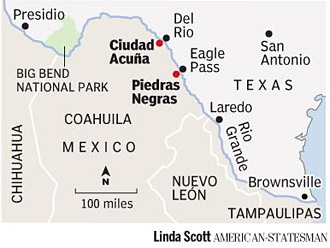
|  |  |  Editorials | Environmental | December 2008 Editorials | Environmental | December 2008  
Mexico Planting Own 'Green Wall' Along Border
 Jeremy Schwartz - Austin American-Statesman Jeremy Schwartz - Austin American-Statesman
go to original


| | Carlos Lombardo Gomez and Gabriela de Valle del Bosque, with the Coahuila environmental agency, are spearheading the effort to plant 400,000 trees along the Mexican side of the border. (Jeremy Schwartz/Cox Newspapers) | 
|  |
Line of trees to serve as protest against U.S. barrier, environmental awareness booster.

Ciudad AcuA, Coahuila Tractor-trailers rumble across the bridge above, but down on the Rio Grande, it's a peaceful autumn morning as ducks paddle the river and herons glide from bank to bank.

On the U.S. side of the river, in Del Rio, plans are moving ahead for a controversial security wall that will eventually stretch across 670 miles of the southwest border.

But on the Mexican side, authorities have begun work on an entirely different kind of wall: a so-called green wall, made of 400,000 trees to be planted along 217 miles of the Rio Grande. Eventually, Mexican leaders hope the green wall will stretch the entire length of Mexico's shared border with Texas.

Officials in the state of Coahuila, where the project is beginning, call the green wall a rejection of the U.S. border barrier. The local Mexican officials hope the clusters of cypress, mesquite and ash trees will stand in stark contrast to the concrete and steel fencing being erected by the U.S. Homeland Security Department.

"This is a signal of protest, but it's also an opportunity for dialogue to find shared solutions to the question of immigration," said Gabriela de Valle del Bosque , Coahuila's environmental policy coordinator .

De Valle said the green wall will be an opportunity to bring more environmental consciousness to Mexican border communities. Area residents also will participate in riverside cleanups and classes on ecology and recycling.

Local officials hope the green wall will bring more attention to environmental worries associated with the U.S. border wall, particularly the migration of species such as white-tailed deer.

"If they put in the wall, Mexicans will find another way to get across, but the deer and other animals are not going to find a solution like Mexicans will," said Carlos Lombardo Gomez, who is in charge of technical matters associated with the green wall.

Coahuila Gov. Humberto Moreira said the green wall will result in Mexico's longest parkland corridor.

Moreira is no stranger to grand gestures. His administration has garnered national headlines in Mexico by ushering in a gay marriage law and has promised a state death penalty for murderous kidnappers, even though Mexico now outlaws the death penalty.

At a ceremony marking the start of the green wall, Moreira blasted the U.S. border barrier as a "wall of hate."

U.S. officials say the border fence is needed to bolster security along the southwest border. And supporters of the U.S. border wall warn that Mexico's green version could potentially aid drug runners and human smugglers.

Jim Gilchrist, president of the Minuteman Project, a U.S. activist group that monitors the border flow of illegal immigrants, said the green wall will "provide effective camouflage for criminal drug and human cargo cartels as they mass their illicit products behind the tree lines, awaiting delivery into the U.S. under cover of darkness."

So far, the state of Coahuila, which extends opposite Big Bend National Park almost to the outskirts of Laredo, has planted 2,500 trees along 25 miles of border. The state has approved about $1 million for the tree-planting program. Plans would extend the green wall in other border states such as Tamaulipas and Chihuahua.

The U.S. border wall is unpopular along much of the Texas border and has been opposed by most border communities in the state.

Despite that opposition, federal officials say that 90 percent to 95 percent of the 670-mile barrier should be completed or under construction before President Bush's term ends in January.

The City of Eagle Pass recently lost a court battle against the U.S. government over the border fence, and construction has begun near the city's downtown. Mayor Chad Foster , one of the border wall's most outspoken critics, said he doubts the change of administrations will halt the wall.

"I don't think President-elect Obama will take office soon enough to impact (the) damage being done in our town," Foster said.

So far, 426 miles of pedestrian and vehicle fencing have been built, according to the Homeland Security Department, but that includes just 25 miles in Texas.

Federal officials plan to build 116 miles in the state.

In Mexico, few think the green wall will have any real impact on the U.S. border barrier, but local residents are happy that it will bring more green spaces and parks.

Arturo de la Cruz Talavera, who runs daily at a park beneath the international bridge in Ciudad Acuña, is looking forward to the day when the green wall saplings grow into mature trees.

"The green wall is in favor of life, it will create oxygen," he said. "It's not like the steel wall, which just rejects." |

 |
|  |



